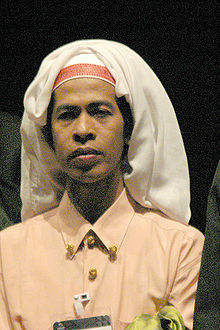Third gender is a concept in which individuals are categorized, either by themselves or by society, as neither a man or woman. It is also a social category present in societies that recognize three or more genders. The term third is usually understood to mean "other", though some anthropologists and sociologists have described fourth and fifth genders.
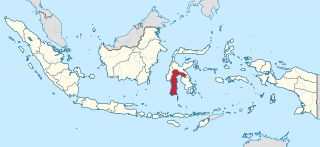
South Sulawesi is a province in the southern peninsula of Sulawesi, Indonesia. The Selayar Islands archipelago to the south of Sulawesi is also part of the province. The capital and largest city is Makassar. The province is bordered by Central Sulawesi and West Sulawesi to the north, the Gulf of Bone and Southeast Sulawesi to the east, Makassar Strait to the west, and Flores Sea to the south.
The following outline is provided as an overview of and topical guide to transgender topics.
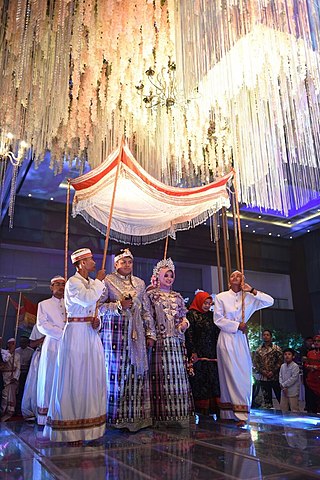
The Bugis people, also known as Buginese, are an Austronesian ethnic group—the most numerous of the three major linguistic and ethnic groups of South Sulawesi, in the south-western province of Sulawesi, third-largest island of Indonesia. The Bugis in 1605 converted to Islam from Animism. Although the majority of Bugis are Muslim, a small minority adhere to Christianity as well as a pre-Islamic indigenous belief called Tolotang.
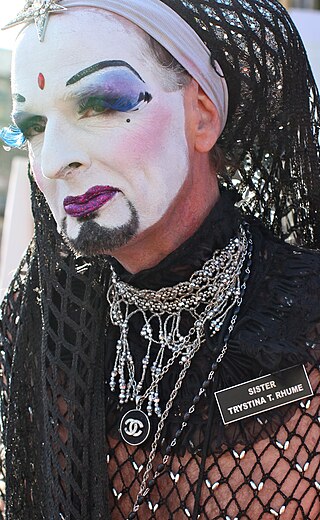
A gender bender is a person who dresses up and presents themselves in a way that defies societal expectations of their gender, especially as the opposite sex. Bending expected gender roles may also be called a genderfuck.
Māhū in Native Hawaiian and Tahitian cultures are third gender people with traditional spiritual and social roles within the culture, similar to Tongan fakaleiti and Samoan fa'afafine. Historically the term māhū referred to people assigned male at birth (AMAB), but in modern usage māhū can refer to a variety of genders and sexual orientations.
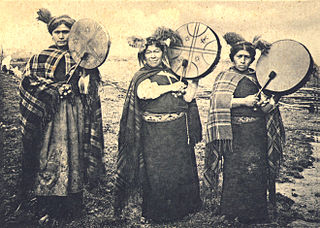
A machi is a traditional healer and religious leader in the Mapuche culture of Chile and Argentina. Machis play significant roles in Mapuche religion. In contemporary Mapuche culture, women are more commonly machis than men, but it is not a rule. Male machi are known as Machi Weye.
The Lontara script, also known as the Bugis script, Bugis-Makassar script, or Urupu Sulapa’ Eppa’ "four-cornered letters", is one of Indonesia's traditional scripts developed in the South Sulawesi and West Sulawesi region. The script is primarily used to write the Buginese language, followed by Makassarese and Mandar. Closely related variants of Lontara are also used to write several languages outside of Sulawesi such as Bima, Ende, and Sumbawa. The script was actively used by several South Sulawesi societies for day-to-day and literary texts from at least mid-15th Century CE until the mid-20th Century CE, before its function was gradually supplanted by the Latin alphabet. Today the script is taught in South Sulawesi Province as part of the local curriculum, but with very limited usage in everyday life.
Wajoq, also spelled Wajo, Wajo', or Wajok, was a Bugis elective principality in the eastern part of the South Sulawesi peninsula. It was founded in the 15th century, and reached its peak in the 18th century, when it briefly became the hegemon of South Sulawesi replacing Boné. Wajoq retained its independence until it was subdued in the early 20th century by the Dutch colonial government. It continued to exist in some form up to the mid-20th century, when the self-governing entity was transformed into Wajo Regency in the newly independent Republic of Indonesia.
The Duano' people, also called Desin Dolak or Desin Duano' are an indigenous people of Malaysia and Indonesia and can be found in islands along the northeastern region of Sumatra, Indonesia where most Duano' people have traditionally lived. They are one of the Proto-Malay group of cultures. Due to their nomadic boat lifestyle, based almost exclusively on fishing and collecting shellfish and crustaceans by using mud-boards, Duano' people are often categorized as Orang Laut, a group that includes the Urak Lawoi’ people and Moken people of the northern region of the Malacca Strait and the Andaman Sea. Although there are similarities in their way of life, they are a separate ethnic group. Citing their own language, culture, identity, and economic complexities, they deny being Orang Laut.
Gender systems are the social structures that establish the number of genders and their associated gender roles in every society. A gender role is "everything that a person says and does to indicate to others or to the self the degree that one is either male, female, or androgynous. This includes but is not limited to sexual and erotic arousal and response." Gender identity is one's own personal experience with gender role and the persistence of one's individuality as male, female, or androgynous, especially in self-awareness and behavior. A gender binary is one example of a gender system.

The roles of women in Indonesia today are being affected by many factors, including increased modernization, globalization, improved education and advances in technology. Many Indonesian women choose to reside in cities instead of staying in townships to perform agricultural work because of personal, professional, and family-related necessities, and economic requirements. These women are moving away from the traditional dictates of Indonesian culture, wherein women act simply and solely as wives and mothers. At present, the women of Indonesia are also venturing actively into the realm of national development, and working as active members of organisations that focus and act on women's issues and concerns.

Lily Yulianti Farid was an Indonesian writer, researcher, educator and cultural activist.

The national costume of Indonesia is the national attire that represents the Republic of Indonesia. It is derived from Indonesian culture and Indonesian traditional textile traditions. Today the most widely recognized Indonesian national attires include batik and kebaya, although originally those attires mainly belong within the island of Java and Bali, most prominently within Javanese, Sundanese and Balinese culture. Since Java has been the political and population center of Indonesia, folk attire from the island has become elevated into national status.
Homosexuality in Indonesia is generally considered a taboo subject by both Indonesian civil society and the government. Public discussion of homosexuality in Indonesia has been inhibited because human sexuality in any form is rarely discussed or depicted openly. Traditional religious mores tend to disapprove of homosexuality and cross-dressing.
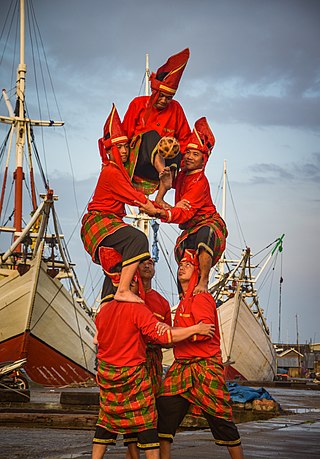
The Makassar or Makassarese people are an ethnic group that inhabits the southern part of the South Peninsula, Sulawesi in Indonesia. They live around Makassar, the capital city of the province of South Sulawesi, as well as the Konjo highlands, the coastal areas, and the Selayar and Spermonde islands. They speak Makassarese, which is closely related to Buginese, and also a Malay creole called Makassar Malay.
Accounts of transgender people have been identified going back to ancient times in cultures worldwide. The modern terms and meanings of "transgender", "gender", "gender identity", and "gender role" only emerged in the 1950s and 1960s. As a result, opinions vary on how to categorize historical accounts of gender-variant people and identities.
The Makassar kingdom of Gowa emerged around 1300 CE as one of many agrarian chiefdoms in the Indonesian peninsula of South Sulawesi. From the sixteenth century onward, Gowa and its coastal ally Talloq became the first powers to dominate most of the peninsula, following wide-ranging administrative and military reforms, including the creation of the first bureaucracy in South Sulawesi. The early history of the kingdom has been analyzed as an example of state formation.

The bodo blouse, locally known as baju bodo, is a sheer and transparent short-sleeved loose blouse, a traditional attire for women of the Bugis and Makassar peoples of South Sulawesi, Indonesia. A bodo blouse is traditionally combined with a matching woven sarong that covered the waist below the body.
